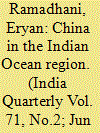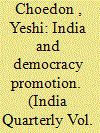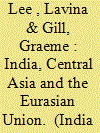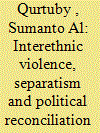|
|
|
Sort Order |
|
|
|
Items / Page
|
|
|
|
|
|
|
| Srl | Item |
| 1 |
ID:
138865


|
|
|
|
|
| Summary/Abstract |
China has been experiencing major transformation in its naval strategy and capacity. Starting off in the late 1980s with rapid naval modernisation, China’s naval operation gradually shifts from the overwhelming ‘near seas’ to the more challenging ‘far seas’. This task is not an easy one. Whilst in the ‘near seas’ China has been enjoying relatively naval superiority, naval operations in the ‘far seas’ is more demanding. Assessing China’s naval capability in three areas of naval forces, naval activities and presence, and overseas naval bases throws a light on the discrepancy between actual capability and intention. Three reasons lend explanation for the hurdles China faces in implementing the ‘far-seas operations’. First, China is preoccupied with the geopolitical struggle in the ‘near seas’, namely, Taiwan, Diaoyu/Senkaku Islands dispute in East China Sea, and the South China Sea dispute. Second, China is confronted with the ‘Malacca dilemma’ that shoves it to rethink its naval ambition. Third, the Indian Ocean Region (IOR) already has two major players, the United States and India, with which China has to struggle to pursue its interests. The three reasons combined with lack of naval capability to accommodate an effective ‘far-seas operations’ are accountable for China’s confined strategy in the IOR.
|
|
|
|
|
|
|
|
|
|
|
|
|
|
|
|
| 2 |
ID:
138866


|
|
|
|
|
| Summary/Abstract |
When the Western countries confronted backlash in their promotion of democracy, they wooed India to join them. India has shown reluctance to join them due to various factors. It starts with discussion of how it was inconceivable for India to promote democracy during the Cold War and then examine factors that made India reticent to commit itself to democracy promotion in the post-Cold War. The paper discusses the reasons as to why a nuanced shift towards supporting democracy promotion has taken place in the turn of the Century and how this shift is made with the intention of making a difference through participation rather than openly protesting and standing aloof on principle ground. The main focus of the paper is to highlight how India provides democracy assistance differently from that of the Western countries and what kind of tangible assistances India provided to those who sought. It highlights how, keeping in view the sensitivity of sovereignty among the developing countries, India uses term such as ‘democracy assistance’ or ‘democracy support’ instead of ‘democracy promotion’ and how it adopts policy of providing democracy assistance only when requested and it follows top-down approach, dealing mainly with the sovereign states and their institutions. It ends with an emphasis on the value addition of having diverse approaches to spreading democracy.
|
|
|
|
|
|
|
|
|
|
|
|
|
|
|
|
| 3 |
ID:
138863


|
|
|
|
|
| Summary/Abstract |
India has had long-standing interests in the Central Asian region. Vladimir Putin’s proposal for a Eurasian Union and the recent announcement of the creation of a Eurasian Economic Union (EEU) raises some important questions for this. What impact will the EEU have on Indian ambitions? We argue that all three Indian initiatives to ‘connect’ to Central Asia—the International North South Corridor, the IPI, and TAPI—now either have Russian support or involvement and do not pose a threat to Russia’s interest in maintaining its status as ‘first among equals’ in Central Asia. Further, if the proposed EEU gains traction it will enhance Russian influence over the states of Central Asia, which could in turn enhance Indian interests by facilitating greater access to trade and energy resources, blunting future Chinese expansion and providing a barrier to any expansion of Pakistani influence in the region.
|
|
|
|
|
|
|
|
|
|
|
|
|
|
|
|
| 4 |
ID:
138864


|
|
|
|
|
| Summary/Abstract |
This comparative article discusses the local dynamics of interethnic violence and separatist movement in Turkey and Indonesia, and examines the role of the central governments in these two countries in responding to, and resolving, the conflict and separatism. More specifically, the article focuses on Turkish–Kurdish conflict and Indonesian–Acehnese violence, and explores perspectives of the secessionist groups of Kurdistan Workers Party (PKK) and Free Aceh Movement (GAM) with regard to the quest of justice and conciliation. The heart of this article is to investigate the dynamics of micropolitics of political reconciliation and attempts at conflict resolution and peacebuilding between Ankara and PKK as well as Jakarta and GAM aiming at identifying the root causes underlying Turkey’s failure and Indonesia’s success in addressing their ethnic problems.
|
|
|
|
|
|
|
|
|
|
|
|
|
|
|
|
| 5 |
ID:
138862


|
|
|
|
|
| Summary/Abstract |
The ascendance of Narendra Modi to the post of India’s Prime Minister comes at a time when Asian geopolitics is in a state of flux. The rise of an assertive China and the resurgence of Japan under Shinzo Abe uniquely positions India as a stable, democratic force that the U.S. and Japan could partner with in order to maintain influence in the Asia-Pacific. India’s rise as a major power promises to transform the Asian security architecture from a purely Asia-Pacific security system to a broader “Indo-Pacific” framework, which includes India. However, settling the sub-continental fronts with Pakistan and Afghanistan will be critical for New Delhi to direct its resources to other regional fronts with China and beyond the Straits of Malacca. It is in this context that both Washington and New Delhi can coordinate their efforts to achieve a common security objective in the subcontinent and support India’s economic rise that complements U.S.’ pivot to Asia. An enhanced economic and security relationship with Washington can bolster India’s engagement with Asia and provide New Delhi an opportunity to be a part of a multilateral hedging system that strengthens its bilateral position vis-à-vis China and its South Asian neighbours. Yet, even as India strives closer to the U.S. and Japan, it will refrain from forging an overt security alliance under a U.S.-led architecture and continue to engage in a hedging policy to maintain maximum freedom of diplomatic maneuver.
|
|
|
|
|
|
|
|
|
|
|
|
|
|
|
|
|
|
|
|
|